Tires A Collection of Comments
You need Load Range E Tires for an H1
- Balancing Wheels
- Article on Wheels
- How to Lift Your Truck
- Air Pressure On and Off Road
- Largest Tire you can run
Updated March 18, 2022
Major Sections
Important!!!: There have been varied results running certain model tires on Hummers. A Hummer is a heavy vehicle. It's imperative that you only run tires that have the proper load rating for the truck. All factory tires for the Hummer are Load Range E. Running under-rated tires can lead to blowouts.
Dry Rot
There are many used tires and older tires on Hummers these days (2012) especially since the last year of the H1 was 2006. This means that most if not all of the original Hummer tires are past their prime and are candidates for dry rot. Dry rot is the deterioration of the tire's structural integrety due to age and exposure to UV light. Dry rot can cause sudden catastrophic tire failure, possibly resulting in injury or death. Dry rot has nothing to do with the amouont of tread. A brand new tire that's been sitting around can be dangerous.
This is what I read on eHow.com "Tire age is the most important factor to consider when buying new or used tires. Just because a tire is brand new does not ensure that it is safe to use on a vehicle. As tires age the rubber breaks down and begins to crack, which can result in devastating car wrecks. For optimum safety, do not buy tires manufactured more than six years ago, learn to decode tire identification numbers, and always determine tire age before you buy new tires."
The H1 tire arena is getting more complicated every day. The issues involve not only which tire to get but which tire will fit the wheels you own or are planning to get. All the Hummer wheels up to the model year 2000 are 16.5 inches in diameter. In 2000 we saw the first 17" factory aluminum wheel and by 2001 all the factory wheels were 17". Goodyear stopped making 16.5" GSA's and 17" GSA's in 2011. The 16.5" MT's which are terrible anyway are impossible to get due to the military's demand (2000). If you have 16.5" wheels your choice is becoming limited and prices are rising. If you are running 16.5's make sure that you have a spare. If you get caught out on the road nobody will have a replacement tire.
17" wheels are a universal diameter used on many other vehicles so the tire manufacturers produce large quantities in that size. This means better availibility and lower prices through competition. Note: Because the military sometimes uses much of Goodyear's capacity there are times when large tires are hard to get. The price of 17" GSA's has risen as high as 400 each (November 2003). As of Sept 2004 the tires seem to have started to flow again and the prices are back down to normal levels (300 area). Of course, GSA's are no longer made in a size for a Hummer.
Because of this scenario many owners are switching to 17" and 18" wheels. All the 17" wheels are aluminum which is another plus because they weigh much less, run truer and are stronger. The Hunter GSP 9700 measured my aluminum 17" wheel lateral runout (side to side) at .005" and radial runout at .0100. Less weight means better handling, improved wear on all suspension components and easier balancing.
The latest tire and wheel size for the Hummer is 18". Many of the tire manufacturers are making some pretty tough looking 18" tires. Check this out. 18" tires are another standard size so I expect there to be an ample supply.
The biggest complaint I get is vibration. Read this article on Balancing and Mounting wheels.
Info below from tirerack.com website.
Plugging a Tire
by Tom Cepek 8/31/2003
Plugging a tire can be safe and permanent, depending on where the hole is located, how large the hole is, what type material the tire is constructed of, and what type and quality of patch/plug you use.
I assume you are talking about a Goodyear original equipment type, and if the hole is in the tread area, you can effectively plug the tire and use it for quite some time, but if used continuously on the vehicle, it must be monitored to make sure that you are not getting any "wicking" in the cords, occurring from the elements.
"Wicking" is a simple term, which is used to indicate that water, air, or other substance is being drawn into, and through the cord or cords of the tire, to include fabric and steel.
If you have a steel belted tire, it’s possible for those elements to creep up the cord line, create some oxidation, such as rust, and thereby delaminate the belting material from the rubber, and cause a separation of the two dissimilar materials.
The same holds true for cord, such as nylon, rayon, Kevlar, etc.
I've seen plugged tires run for their normal calendar, or mileage expected duration, and I've seen those that have failed within a short time. It's just a matter of preparation, and of course, some luck.
There is available, and I suggest using, a plug that looks as though it has a tire patch on one end of the plug, but it must be installed from the inside of the tire.
You prepare the tire by cleaning the hole, buffing the point inside the tire where the hole is located as if you were going to patch the tire, pull the plug end through the tire, stitch the patch in place, and cut the excess plug off, down to the tread depth and you're done.
Once that has been accomplished, you should have a perfectly good tire, but you must monitor that spot on the tire to make sure that you don't have any additional problems.
You can even patch, but not plug the sidewall of a radial tire, as there are Radial patches made for that purpose. Of course, it depends on the type and size of damage to the sidewall, but if it's small, they can be patched.
Radial or Bias Tires ?
A bias belted tire has the internal cords laid in a criss cross pattern while radial tires have the cords like a tank tread wrapped radially around the tire.
Radials are usually better because they flatten out at the point of contact with the road and put more tread on the ground. When you let air out of your tires for off roading radials will give you a large flat footprint for better traction.. They also track straight on the road.
The typical applications for bias ply tires in todays market would be primarily Rock Crawlers, however, many guys use them off road in lieu of radials because of the flexiblity throughout the entire carcass area. As your truck traverses or climbs up an area with a lot of large rocks the bias belted tire will wrap around the outcroppings and grip better than a radial. They self clean a bit better in the mud and snow since they can flex more in the tread area of the tire without a steel or other belting material in the tire. Bias tires do not track as well on the road and have a greater tendancy to wonder compared with radials. When your vehicle sits parked with bias tires it can cause a temporary flat spot where the tire meets the road that will shake the truck until it rolls enough to get round again.
Considerations when Running Tall Tires 40 - 42"
A taller tire has larger sidewall area and will flex more than a narrower sidewall. A tire that flexes more, will heat up more. A 42" is not likely to be a safer tire than a smaller tire. If you're going to run a 40" - 42" tire you need to lift the body 2".A 2" lift is pretty easy. Once you go over 2" you start to run into problems with shift linkages etc. A 42" tire needs more then a 2" lift.
Any tire with a larger diameter will change the effective gearing of the truck. Installing large diameter tires will reduce the torque at the wheels. Your speedometer won't read right anymore either. It's not uncommon in the world of 4 wheeling to change the differential gears to compensate for tire size. Lots has been written about this so search the net if you want to know more.
A taller tire will place it even closer to exhaust system generated
heat under the H1's left rear wheel well that could lead to real problems at
sustained highway speeds! I actually wrapped the exhaust in the rear wheel well with header tape to keep the heat down because I have radio equipment mounted inside the truck (wagon) on top of the wheel well.
Largest Tire You Can Run on Stock Rims
The 38x15.5R is the largest tire you can put on the rim without doing mods like lifting your truck. You do have to watch the width because tight turns might bring the tire in contact with part of the suspension. The wheel size isn't a factor so any 38x15.5 that takes a 16.5, 17 or 18" wheel is fine. Technically, an 8.5" rim width.is designed to take 12.5" width tires. 15.5 tires generally require 10-13" rim widths but on a Hummer the 8.5 to 9.5 rims seem to work well.
One of my customers has aluminum 18" rims with the 38/15.50R-18 Open Country MT's on a truck that is not lifted. He adjusted his wheel stops (on the geared hub) to prevent rubing against the sway bar. With new springs in the front there could be slight rubbing if the suspension is completely compressed. To quote my customer "kinda tight when the suspension is completely compressed". You probably would be ok on the road. If you were careful not to beat it, off the road would work but no high speed off the road obstacles or jumping. There doesn't seem to be any issues in the rear. Remember, you do this at your own risk.
When you put a wide tire on :
- The tire can 'bow' in the middle causing irregular wear if the pressure is off or the wheels aren't wide enough..
- run into the steering components when you turn sharp.
- The tire sticks out beyond the body and hood
- Mud and junk gets thrown all over the sides of the truck.
- If you hit a really big bump the tire can hit the edge of the hood or body and cause damage. That's why you might need a body lift.
- The larger the tire the heavier it is. This causes steering wear and sacrifices some handling.
- Lower gas mileage. I lose about 1mpg running wide 38's.
- Harder balancing.You may need more weights to balance the tire.
You will need to remember to:
Adjust your tire pressure so the whole tread contacts the ground. This is one way to set the correct pressure. Take a piece of chalk or a white grease pencil (my favorite) and draw a line across the tread from sidewall to sidewall. Take the truck out for a spin. Adjust the pressure so you get almost all of the chalk line gone.
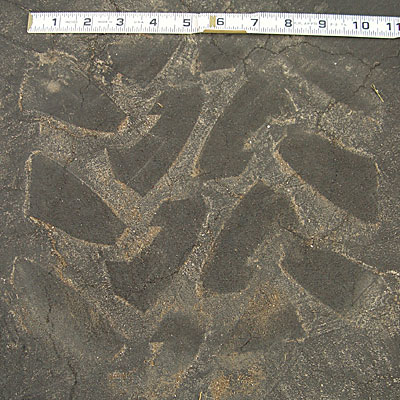 Another way I do the same thing is to get the tires wet and drive the truck on a nice black ashphalt driveway to see the tread pattern. In fact I recently washed my truck and when I pulled it in the garage I found some very nice tread patterns. This is a Toyo Open Country MT at 30 psi.
Another way I do the same thing is to get the tires wet and drive the truck on a nice black ashphalt driveway to see the tread pattern. In fact I recently washed my truck and when I pulled it in the garage I found some very nice tread patterns. This is a Toyo Open Country MT at 30 psi.
I can tell you for sure to run Goodyear GSA's and MTR;s at 35 psi cold. Check your pressure with a gauge because my CTI gauge reads 37 psi when the pressure is 35.
Most 37x12.5Rx16.5 or 17" tires have a higher load carrying capacity (an average of 300lbs per tire more load capacity on 37's than 38's. PJ's 38's have a load capacity of 3640 lbs, PJ 37's have a load capacity of 3970), making them theoretically safer when hauling.
38's are a heavier tire - about 10lbs per tire more. Not that an extra 40lbs is major for our truck...but it can theoretically introduce increased stress and cause increased wear on suspension parts.
Speedometer/ odometer correction. Running larger diameter tires means your speedometer reads slower than you actually are traveling. 60mph indicated is actually 62-63mph.
AMG was invalidating warranty claims for suspension parts like ball joints, idler arms and pitman arms if you are running larger then stock tires.
You gain about 1 inch of clearance. Most 37" tires range from 36.5 to 37" in true diameter. PJ's (and Interco Super Swamper SSR Radials) run 38.2 inches for the 38" tires. This is, of course, when the tires are new.
 Note: As of 2011 The Goodyear GSA is no longer available in a size for the Hummer
Note: As of 2011 The Goodyear GSA is no longer available in a size for the Hummer
A good replacement is the Yokohama Geolandar AT/S 37x12.5x17.
The newer 17" aluminum wheels are very good. A 17 with a GSA/ MTR weighs 116#. This makes it much easier on all the front end parts and improves handling because of the reduced unsprung weight. The tires can be mounted and balanced at a normal tire place. The aluminum wheels have a large bead area which keeps the tire on the rim. I've run pressures down to 12 with no problems but I wouldn't go less then 15 for really heavy pulling. I've run up the slick rock at Moab Ut. at 12. I don't like to leave it that low because I don't want to cut the sidewalls on the rocks. I'll usually run 15 off the road.
The GSA's are the best overall street tire for the Hummer. They give the best ride, handling and gas mileage. Keep in mind that there isn't one tire that will do it all. The GSA's are the best on road in sand and on slick rock. They are as good as any suv tire in the snow. They handle wet roads very well. They are no good in mud. The new GSA's have the same sidewall as the MTR's. I run my GSA's at 35psi cold. If you drive at 62mph you can get 14 - 15 mpg. Drive at 70 and your down to 12 - 13. That gives you 70 to 80 miles more range. A new 37.5x12.5x17 GSA has a tread depth of 17/32 and has a load range of E.
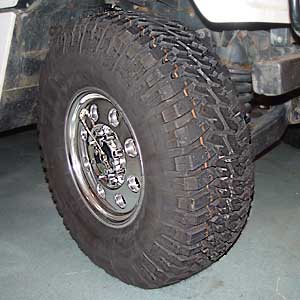 The MTR's seem to have a harder rubber compound and wear very well but they ride harder. You'll notice it the first time you go over railroad tracks. They also can get about 1 mpg less then GSA's because of the aggressive tread. They are one of the best all around tires you can get. They are good in the mud but not as good as specialized tires like Super Swampers. I was really watching the MTR's this year at Moab because I was curious how they would do. They (MTR) are good on the slick rock and sand but not quite as good as the GSA's because they are stiffer and have less tread area on the rock.
The MTR's seem to have a harder rubber compound and wear very well but they ride harder. You'll notice it the first time you go over railroad tracks. They also can get about 1 mpg less then GSA's because of the aggressive tread. They are one of the best all around tires you can get. They are good in the mud but not as good as specialized tires like Super Swampers. I was really watching the MTR's this year at Moab because I was curious how they would do. They (MTR) are good on the slick rock and sand but not quite as good as the GSA's because they are stiffer and have less tread area on the rock.
I just swapped out a set of Aluminum wheels with GSA's for a new set of wheels and MT/R's. The MT/R's are just about as quiet as the GSA's which is surprising for such an aggressive tire. The MT/R's are not nearly as good on wet roads as the GSA's. That being said the MT/R's are very good on snow covered roads and slush. I run the MTR's at 35 psi on the road. A new 37.5x12.5x17 MT/R has a tread depth of 20/32 and has a load range of E. When you measure the tread depth of an MTR make sure you measure the deep treads in the center.
My truck is a daily driver, normal city street/ highway kind driving that I take on summer off road trips. I run 35 pounds front and rear with the GSA's and the MT/R's.
If you keep the tires rotated and balanced you should get 50,000+ miles of life. If you have a spare you should rotate it in with the other tires. This will boost your life by 20%.
The MTR's and GSA's cost about the same. The MTR's are around (April 2006) 308.00 and the GSA's are 278.00. These prices do not include tax and freight. I had MTR's all last year (2002) on one piece Aluminum wheels. I ended up selling them off this spring and went back to the GSA's. I've been running GSA's for 8 years and have learned how to deal with them in the mud when I have to. I really don't like running in the mud so I don't go to events where I know that's all there is. I like running the ghost town trails in Colorado and rock crawling in Durango / Moab.
For a change of pace in 2006 I got MT/R's again. The MT/R's are really very quiet. You need to rotate them often just like any aggressive treaded tire to keep them in good shape and maintain their quiet ride. The biggest problem with the MT/R's is handling on the road in the rain; at least when they are brand new. All I can say is be careful and don't follow too close. The MT/R's are much better in the snow and slush than the GSA's.
I did see the 40" MTR on a turbo diesel with a 1" body lift. This is a nice setup. The 40" MTR does not have the same load rating as the 37.5 MTR but I have heard of owners using them on a lightly loaded truck. The biggest consideration will be the handling of the truck. The big tires will have a tendency to flex and cause under and over steer. When you first put the tires on the truck take it easy in the turns until you get the feel of it.
Here's what one owner says: I am running the 40" MTR's and I love them. These are way better than the stock GSA's that I was running. To be honest the MTR's are barely noticeably louder on the road than the gsa's. I am running a 96 open top so sound is not that key to me. Just thought I would let you know that I am very pleased with my tires and would recommend them. The 40" MTR's sounded interesting until I noticed that they are load range C. The 37" MTR's are load range E. Big difference, so don't load your truck up with 2000 pounds of junk. I also wouldn't go pulling any 10,000 pound trailers. I run 40" MTR's on my truck with a 2" body lift.
.
I too am running the 40" MT/R's with a 2" lift. I couldn't be happier with the results. I don't hit nearly as many things on the rocker panels as before, and the tires are very well equipped to handle most off roading conditions as well as behaving quite well on the street. I had gsa's prior, and to be quite honest, the MTR's are not much louder. The other added benefit is highway speed is increased due to the larger diameter tire. Of course the converse to this is an overall reduced low gear due to the larger tire diameter.
Be very cautious about running any
"Load Range C" tires on an H1. With a lighter rated tire than AMG recommends combined with the heat the Left Rear tire can be subjected to (because the exhaust pipe runs in the top of the wheel well) may spell
trouble.
I ran GSA's in all conditions of wheeling for about 2 years; I bought tire chains, and used them when I was going to encounter muddy conditions. With the chains, the truck was nearly unstoppable in the mud... so keep in mind that if you decide to keep the GSA's, but want to hit the mud sometimes, chains take up less space than an extra set of wheels with mud tires.
Actually, you could expect the GSA tires to last a while. I got 38,000 miles out of my GSA's, better wear than I got from any set of tires on any of the 35 vehicles I ever owned. Also was getting about 12-13mpg. My current Super Swampers will probably last 10-12,000 miles and I only get 10mpg or less in town. Soon as I can afford 17" rims, I'll be looking for GSA's again for road travel. I love the swampers for off road though.
TOYO Open Country MT's
Toyo Inflation Chart
Toyo and Nitto are the same company. These tires are made in a brand new plant in the USA in White, GA.
The last time I ended up getting MTR's because the Toyo's weren't available because they were just opening their new plant in GA. It's now a year later. I called a couple of friends who are running the Toyos and they still love them so the time has come to finally try them out.
They mounted and balanced flawlessly (I think the most a tire needed was 2-3 ounces for weight, although I believe two required nothing to balance. The Toyo 37 x 13.5 x 17 are a little bit taller than the MTR's. or GSA's. My speedometer always showed a little faster then my gps with the MTR's. I just noticed today that the gps is now a hair faster at 55 then the speedo running the Toyo's. They really look good. The tread pattern and the heavy sidewalls make the truck look much more aggressive.
The Toyo's ride very smooth and quiet on the road. Going over railroad tracks doesn't shake the truck apart like the Goodyear MTR's.
After a long hiatus I finally had a chance to go wheeling in Colorado with these tires. Often times when I first hit the trail I air down simply to get a smoother ride and not shake the daylights out of the truck especially on washboard roads. I run 35psi on the road. With GSA's and MTR's I usually have to air down to 15 psi to begin to get a smoother ride. Without beadlocks I really don't go much lower. When I started letting the air out of the Toyo's the ride was considerably smoother at 20 psi than the Goodyear's were at 15. This is a good thing because the higher pressure will keep the tires on the wheels.
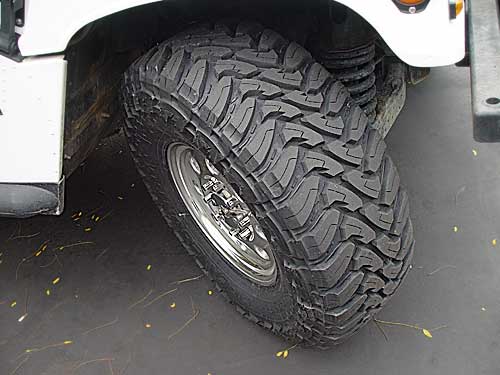
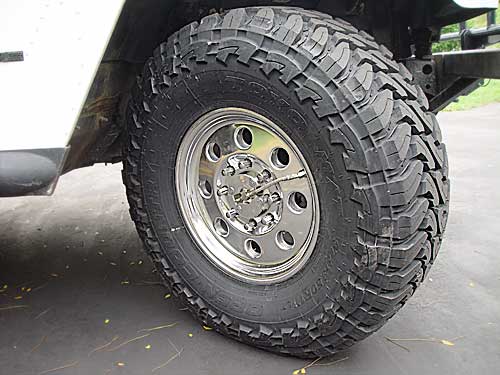
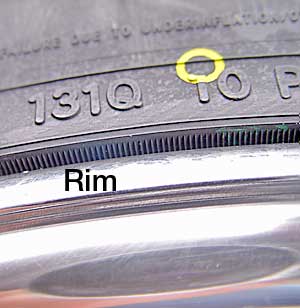 37x13.5x17 Load range E for 17" wheels.
37x13.5x17 Load range E for 17" wheels.
38/15.50R-18 Open Country MT Load = 3960 lbs @ 50 psi
37.7 Outside Diameter for 18" wheels.
This tire looks a lot like the MT/R but is more aggressive. It's a little quieter then the MTR.
This tire has a rim flange protector. This ridge extends beyond the width of the wheel rim and acts as a bumper to protect the wheel from scratches and other damage. In other words, the tire ridge, not the expensive wheel, hits the curb. It also keeps sand and branches from getting into the bead when running low pressure. I'm waiting to see how this works. The only place on any of my wheels that gets scratched is the rim.
Tread depth is 21/32's
The Toyo Open Country MT on an aluminum wheel weighs 132 pounds.
Toyo's answer to the Goodyear GSA, the Open Country A/T
 If you want a GSA type of tire that looks great and balances well try these Toyo's. These 37x13.5x17 Load range E tires are mounted on aluminum wheels. These tires also come in
37/14:00R-18 Open Country AT Load = 3640 lbs @ 35 psi,
36.7 Outside Diameter for 18" wheels.
If you want a GSA type of tire that looks great and balances well try these Toyo's. These 37x13.5x17 Load range E tires are mounted on aluminum wheels. These tires also come in
37/14:00R-18 Open Country AT Load = 3640 lbs @ 35 psi,
36.7 Outside Diameter for 18" wheels.
Branded 355/65R-18 37-13.50 R-18
This tire has a rim flange protector.
The Interco (Super Swampers) Tire Section got so Large that I put them on a Separate Page.
Cooper Pro Comp Xtreme AT's
On 2/24/06. I also found that Cooper had a major tire recall due to rubber compound problems causing leaks in tires made in mid to late 2005. The 37 x 12.5 x 17 are around 300 each (5/2006)
You have got to take a look at the new Pro Comp Xtreme AT's (pictured Bottom) in 37 x 12.5 x 17 is 252 each (May 2006). I've driven on GSA's, not impressed one single bit. I also felt they were one of the worse wet weather tires I've been on. I thought is was just me at first, but looking at reviews from others on Tire Racks website, I see that I am not alone in this opinion. The GSA's that I've been on were 16.5 units, so I can't comment if Goodyear has done any upgrades to the carcass on the 17" rim model. I actually felt that the MTR's rode better.
 The Pro Comps are made by Cooper. I feel that belt design and construction is superior to the GSA's. I've driven on the Xtreme AT's mounted on a Super Duty 4wd Powerstroke. Smooth, quiet and handled very well. Can't vouch for 4 wheeling, but that's not what I want in an highway tire. You are fortunate that you have two sets of rims so you can have the best of both worlds.
The Pro Comps are made by Cooper. I feel that belt design and construction is superior to the GSA's. I've driven on the Xtreme AT's mounted on a Super Duty 4wd Powerstroke. Smooth, quiet and handled very well. Can't vouch for 4 wheeling, but that's not what I want in an highway tire. You are fortunate that you have two sets of rims so you can have the best of both worlds.
The Pro Comp Xterrain MT
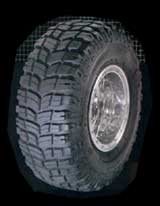 is definitely a good all around tire, about the same noise characteristics as the MT/R. They wear reasonably well but faster than MT/R's. They took a bit less weight to balance.
is definitely a good all around tire, about the same noise characteristics as the MT/R. They wear reasonably well but faster than MT/R's. They took a bit less weight to balance.
I was happy with the traction on rocks, snow, mud, etc; especially after airing them down. The only thing I didn't like so much is that the void between the lugs is a bit smaller than I'd like. After using both tires I find I like the MT/R's a bit more. In snow and wet rock the MT/R seems to work a bit better.
The Pro Comp X Terrain pictured is The 37 x 12.5 x 17 and is around 300 each (5/2006)
BF Goodrich All Terrain T/A KO
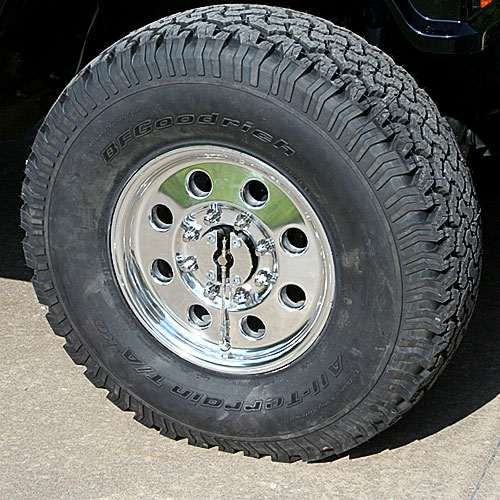 These tires are a great substitue for the now discontinued Goodyear GSA's. I have had the BFG All Terrain TA/KO's on my rig for about 22,000 miles and I love them. No noticeable wear, can't hear them over the truck noise, no problem getting them balanced or keeping them balanced, I've done some "light" off roading with them and they seem like a great tire. Here in the "sticks" of Upstate NY with all the snow we have now... I haven't had a problem yet with them.
These tires are a great substitue for the now discontinued Goodyear GSA's. I have had the BFG All Terrain TA/KO's on my rig for about 22,000 miles and I love them. No noticeable wear, can't hear them over the truck noise, no problem getting them balanced or keeping them balanced, I've done some "light" off roading with them and they seem like a great tire. Here in the "sticks" of Upstate NY with all the snow we have now... I haven't had a problem yet with them.
The BFG All Terrain, is probably the best riding tire on the H1, it's very soft feeling on the road, and the availability is usually very good. As far as quiet goes, I don't think there's anything that would be as quite at the GSA.
The 37x12.50x17
The BFG T/A KO's are great all around tire if your not planning to "Mud" the rig . They will out last almost any tire on the market and the new KO design make them a great off road tire also (just not for the deep gumbo.
In regards to wear, the BFG All Terrain's will probably give you your best wear. On other vehicles that I've had BFG's on, they wear like iron.
BF Goodrich Mud Terrain T/A KM2
This is the Goodrich off-road maximum traction tire. It is snowing like crazy here in NY so I got to try out my BF Goodrich Mud Terrains 37x12.5xR17 in unplowed and plowed. The unplowed about 6-8 inches. All I can tell you is they are FREAKIN AWESOME. Stop as well as they start. Worth every penny I spent on rims and tires.
 Wait till you get in the mud with them. I had them on my jeep, when the mud starts flying pray you don't get dents. The next best thing to those in mud are the swamper radial and boggers.
Wait till you get in the mud with them. I had them on my jeep, when the mud starts flying pray you don't get dents. The next best thing to those in mud are the swamper radial and boggers.
I have been losing about ten pounds on my rear tires every night. Brought the truck into the dealer for a look-see at the CTIS and the dealer noticed about ten evenly distributed "slashes" on the tires near where the sidewalls meet the tread.
I've seen this many times with BFG tires, and rarely with other types. If this, in fact, is your problem, it's called Torque Cracking and has a tendency to do this if the tires are run at lower pressure over an extended period of time.
BFG had a big problem with this when they first introduced the 31/10.50R-15 Radial TA, and it was caused by the use of Rayon Cord as a body ply. It turned out that the Rayon is not that great of a body ply material and is not as extensible as it needs to be. This can happen on any tire, and is typical of too low pressure and over heating of the tires .I would make sure you have them looked at closely, and perhaps have them adjusted by a BFG Zone manager. What can happen with those cracks, is that they begin to split open enough to let the elements get to the tire cord, and when that happens, the elements, (air, water, salt, etc.) can begin to "wick" through the tire cord, and cause separations, bubbles, etc. and eventually a failure. This problem has been corrected in the KM2.
I have had the BFG Mudders and AT'S. The AT"S will last longer but do not look as tuff. The mudders also have performed better off road. They seem to wear really well and ride smooth. Around 40 psi seems to work best on the road for my truck.
New 17" Tires as of 3/17/04 Load rating of "E" or "D"
Goodyear MT/R
37x12.5R-17 E (limited availability)
BF Goodrich All Terrain T/A KO
37x12.5R-17 D
BF Goodrich Mud Terrain T/A KM2
37x12.5R-17 D
BF Goodrich Baja T/A
37x12.5R-17 D
Interco IROK:
37x12.5R-17 E
39.5x13.5R-17 (E is the rumored load rating, to be released in 2004)
Interco SSR Series Super Swamper Radial/TSL
37x12.5R-17 E
38x15.5R-17 E
Interco TrXus STS All Terrain
38x15.5R-17 E
Interco TrXus MT
38.5x14.5x17 about 350 ea
Mickey Thompson Baja Claw Radial
37x13R-17 D
Dick Cepek Radial Fun Country II
37x13.5R-17 D
ProComp Radial XTerrain
37x13.5R-17 D
New 18" Tires
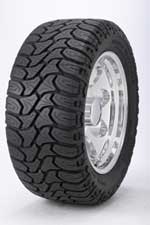

MICKEY THOMPSON TIRES
On the left - 38/15.50R-18 Baja Claw Load = 3415 lbs @ 50 psi
Load Range "C"
Tire is actually branded 395/65R-18 It's the ATZ which is a very nice highway tire and all terrain tire.
On the right - The MTZ 37x13.50R18 is a great mud and snow tire.
NITTO
My experience with Nitto Mud Grappler is that they're noisy. You can't hear yourself think. They are very good in the sand.

38/15.50R-18 Mud Grappler Load = 3960 lbs @ 50 psi
37.7" Outside Diameter
 37/14:00R-18 Terra Grappler Load = 3640 lbs @ 35 psi
37/14:00R-18 Terra Grappler Load = 3640 lbs @ 35 psi
36.7 Outside Diameter
The 37" tire is actually branded a 355/65R-18 but they use
that size in the magazine to promote the tire. Both tires are load range "D"
TOYO - (see pictures above)
38/15.50R-18 Open Country MT Load = 3960 lbs @ 50 psi
37.7 Outside Diameter
This tire looks a lot like the MT/R
37/14:00R-18 Open Country AT Load = 3640 lbs @ 35 psi
36.7 Outside Diameter
Again, branded 355/65R-18
37/13.50R-18
8.5" or 9.5" width
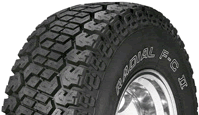 DICK CEPEK RADIAL FC II
DICK CEPEK RADIAL FC IIThe Dick Cepek Radial FC II tire is a great all around tire, and they are now available in 37/13.50R-18, 38/15.50R-18, and 40/13.50R-18, which really covers the asked for size ranges very nicely.
BF GOODRICH
 37/12.50R-18 Mud Terrain KM Load = 3415 @ 50 psi
37/12.50R-18 Mud Terrain KM Load = 3415 @ 50 psi
Load Range "D"
36.8" Outside Diameter.
Nitto Terra Grapplers
I haven't put Nitto Terra Grapplers on my H1 - yet - but I would definitely consider them based on what I now know...
I finally broke down last week and bought a 2004 Diesel Ford Excursion (X).
One of the differences I noticed right away between the X and my old Suburban was that the X 'wandered' all over the road. It was pretty much a full-time job to keep it in a single lane. Honestly, it took a lot of the fun out of driving - and I thought it was the truck!
Today I installed new Nitto Terra Grapplers in place of the BF Goodrich T/A's that it came with. WHAT AN AMAZING DIFFERENCE!!!!
The truck is HUGELY more sure-footed than before. There is virtually ZERO wandering. The truck corners like you wouldn't believe, and stops MUCH better than my old Suburban ever did. I feel like I'm driving an entirely different vehicle than what I drove out of the showroom just last week!
I was going to put Nitto 285/75R16's on the truck, but the tire warehouse didn't have them in stock so they sent over 305/70R16's. Since the diameter was the same, we decided to try them. They drive like a dream and look FANTASTIC! I was originally thinking about replacing the stock 'Limited' wheels, but once I saw them with these tires on them I couldn't believe how nice they looked!
I put new MTR's on my H1 only 3000 miles ago, but if I had to put new tires on it today, I would STRONGLY consider the Nitto's.
I just got my truck back with the nitto's 37x14x18's it rides 200% better, i can cruise at 80 with no vibration, all four tires were perfectly balanced they did not even have to put any weight on them. they are a little pricey but definitely worth it
I have the 37x14 nitto all terrain grapplers, on 18 inch wheels, They aren't as aggressive looking but ride AWSOME on the road.
Goodyear 16.5 x 12.5 x 37 MT's
These are the tires that the military uses. They were the stock tire on all the early Hummers. They ride like hell and are noisy. On-highway expect them to last 30-35K with close monitoring of tire pressure, alignment, balance, rotation, etc.
16.5" Unicure Adventurers
I've been running Unicure's for the past few years. I seem to be getting
30K out of them -- before they are destroyed by something else. Usually, I
manage to mess up the tires through poor alignment or other problems long
before they are actually in real need of replacement from road
wear. Sometimes, I'll tear them up on the rocks first as well.
These MTR - like retreads are a good all around tire that I have on my truck right now. They seem to be a notch better then the unicure MT's that I last had on the truck, but, for the money I would have to say its the best choice, plus they are a little quieter then the unicure MT's were. One problem I'm having is that the retread section is dry rotting after about 2 years.
I've started measuring tire life in months. My MTR retreads (the Unicure Adventurers) lasted me about 8 months. At the end of the 8 months they didn't really have enough tread to be useful off road.
If I had to guess I'd say I got about 10k to 15k out of the Adventurers. Possibly a little more, but not much. They also are a fairly soft compound. But they are also designed for off road use.
Personally I use my truck 75% on road and 25% off road. And when off road I drive aggressively so I want a tire that's got some bite. I don't want to be swapping tires all the time so I'm fine with sacrificing a little on road life in exchange for maximum off road performance. After all, what's another $1k or $2k a year on a truck like ours? I save a ton of money already by doing my own maintenance and using a local shop when possible. I don't mind splurging a bit on tires.
If you don't ever go off road, you may very well get 20k to 30k out of your adventurers.
I think they're about 70 pounds apiece. I have ~9,000 miles on mine. They seem to be wearing quite well, estimated < 20% wear so far. They are noisier than GSA's or MT's, and fuel mileage seems a bit less. At 35 - 40 psi and 60 mph on the highway, I'm getting about 13.5 mpg, versus ~ 14.0 mpg for my previous MT's and ~14.5 mpg for my original GSA's.
The dirt grips (no longer available) are generally much nicer than the re-treads. I've seen too many of the re-tread (Lynch Unicure) bubble or separate over the past 2 years.
We have sold about 5,000 Unicure tires over the last few years and have had very few problems (much better than other tires we have carried). There was a small number of tires that were produced a year or so ago (2004) that had some problems with the rubber compound. The manufacturer has assured us the problem was isolated to a small batch.
For reference, the following Radial tires can be found for a 16.5" rim as of 3/08/2004
Compiled by Steve Yee
Interco IROK:
37x12.5R-16.5 10 ply E
37x12.5R-17 10 ply E
39.5x13.5R-16.5 10 ply E
39.5x13.5R-17 10 ply E
Interco Super Swamper Radial/TSL
38x15.5R-16.5 10 ply E
Interco TrXus STS All Terrain
38x15.5R-16.5 10 ply E
Interco Super Swamper SSR Radial/TSL
37x12.5R-16.5 10 ply E
38.15.5R-16.5 10 ply E
Community Tire Re treading Unicure HMMWV
37x12.5R-16.5
Community Tire Re treading Unicure Adventurer MT
37x12.5R-16.5

